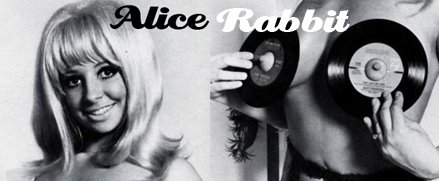Sound Art & Music by artists, another selection by Rainier Lericolais (THT discs) for AliceRabbit.
Side A
Keith Sonnier (USA) - Air to air (ext), 1975
Gabriel Orozco & Manuel Rocha (MEX) - Ligne d'abandon (ext), 1993 (review french/spanish)
Robert Barry (USA) - Sky Land Sea (ext), 1996
Lothar Hempel (GER) - Untitled, 1995
Martin Kippenberger & Albert Œhlen (GER) - The Alma Song, 1990
Jeremy Deller (GB) - Trona Summer (Feat. William Whitmore & Jennie Olsen), 2002
Martin Creed (GB) - I Don't Know What I want, 2004
Side B
Dieter Roth, Gerhard Rühm, Oswald Wiener (GER) - November Symphonie, 1973 [NWW list]
Dorothy Iannone (USA/GER) - Lieber Uecker, 1972
Peter Roehr (GER) - Bodensee, 1966
Christian Marclay (USA) - Untitled, 1996
Pipilotti Rist (CH) - I Like TV (Feat. Wolfgang Capellari), 1984/1998
Pierre Bismuth (F) - Humming (ext), 1995
Xavier Veilhan & David Artaud (F) - Dourdan (edit), 2003
VOLUME 2 (One side = one track) 320/RAR/RS [new link 06/2012]
Get here the volume 1 here (alicerabbit) and at Ubuweb.
2012-06-13
2012-06-10
VA - EARLY DEDICATED JAPAN
 the world of electro-acoustic sound and music 1 (J-Tone, J1250)
the world of electro-acoustic sound and music 1 (J-Tone, J1250)Naughty people ! I don't think you deserve it, but, at last, it's here, in exclusivity for the reader and followers of alicerabbit, an extraordinary focus on the experimental/concrete music from Japan, ripped by Rain.
Tracklisting
1- Toshirou Mayuzumi - “Mandara with source of voice and electronic sound” (1969)
2- Yuji Takahashi + Masahiko Sato - Taklamakan (1974) [Piano, Synthesizer, Electric Piano, Prepared Piano]
3- Jōji Yuasa - "My Blue Sky #1" (1975) "In this work only clicks, pulses and the various kinds of beats induced from them, varying piches, width and their frequency of pulse are adopted. For example, I controlled successively occurring pulses of low frequency sine wave by means of triggering with the frequency of the square wave."
4- Matsuo Ohno - “Electronic Sound - Astro Boy’s b.g.m. d” (1963-66)
5- Yuji Takahashi - Time (1963)
320/RAR/RS (thanks Rain !)
1- Toshiro Mayuzumi 黛敏郎 (1929 - 1997), initially enthusiastic about avant-garde Western music, especially Varèse, but beginning in 1957 he turned to pan-Asianism for new sonorous material. Like the novelist Mishima Yukio, whose novel The Temple of the Golden Pavilion he set as an opera ("Kinkakuji", 1976), Mayuzumi opposed the westernization of Japan and tried to emphasize his native cultural identity in his work.
MANDARA for electronic sounds and voices is borrowed from the vocabulary of Buddhism, evokes the idea of the uncertainty of things here on earth. The work is divided into two sections. The first is composed basically of brief, shrill electronic impulses; toneless sounds gradually impose the sensation of deep breathing, which effects a transition to the second section of the work. This is made up of complex vocal polyphony, in which murmurs, cries, and ordinary speaking are blended with typically Japanese melodic inflections. (wikipedia + analogartsensemble)
2- Yūji Takahashi 高橋 悠治 is a composer, performer, pianist and author, who worked with Iannis Xenakis (he gave the first performance of Xenakis' Herma and Eonta). Masahiko Satoh 佐藤允彦 is a Japanese jazz pianist and composer, born in 1941. (wikipedia, discogs)
3- Jōji Yuasa 湯浅譲二 (1929- ) In 1951, he founded with the composer Tōru Takemitsu and other contemporary artists and musiciansJikken Kōbō (Experimental Workshop), an organization dedicated to the exploration of new directions in the arts, including multimedia. He worked at Boulez's IRCAM. "My Blue Sky No.1," made at NHK electronic music studio, is his final electronic music piece. (wikipedia, jazzloft)
4- Matsuo Ohno 大野松雄 (born 1930), perhaps best known for his incredibly prescient sound-design work on the “atom” (better known as “astro boy”) cartoons made between 1963 & 1966. Before the era of synthesizer, he used mainly transmitters and tape recorders, echo and various tape editing technology freely. He used marimba sound recorded on an open reel tape to generate astro boy's footsteps. He rubbed the tape against heads of open reel deck, moved it back and forth manually, then put some echoes and other effects onto the sound came out by doing 'open reel scratch'. creating just a few second of the sound required an immense amount of time and effort. (mimaroglu)
5- Yuji Takahashi'sTime is a sound-collage piece intended to portray 24-hour cycle in the life of a “salaried worker”. Using what appear to be field recordings of both industrial and natural origins, he combines them with playing on a porcelain percussion instrument invented by Junosuke Okuyama (who also worked with Toru Takemitsu). It’s another impressive track, again beautifully recorded, wherein the sequence of abstract, apparently unrelated sounds manage to convince the listener of their poetic logic. Whether or not the salaried worker would care is another question. (http://www.bagatellen.com/archives/reviews/001014.html)
2012-06-03
THE DEAD MAURIACS - UNE NOUVELLE ASSEZ CURIEUSE NOUS ARRIVE DE RIO DE JANEIRO (2012)
[NPH 006]
tracklist1. Le Horla (8 : 24)
2. When cherished nightmares come true (6 : 55)
2. When cherished nightmares come true (6 : 55)
Another collaboration between AliceRabbit & L'Art Pénultième Éditions (after the Dead Mauriacs's Suite and Carnet de Notes 25 compilation - not available since the megaupload crash, but soon, I promise, it will be on the net again !), I only can thanking HOP for his beautiful works.
As he said : "This music was created for a silent short movie realised by kids in a high school using singing bowls, metal springs, fishing reels, strings, tape manipulation, everything played and assembled on a computer in two days.
The black and white movie is adapted from a short novel by Guy de Maupassant, Le Horla".
If you like Andrew Liles, you would like these short exquisite pieces.
ZIP/WAV/RS or MedFire
Inscription à :
Articles (Atom)


